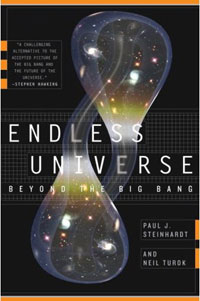Review: Endless Universeby Jeff Foust
|
| “Maybe nature is fundamentally ugly, chaotic, and complicated,” said Nobel laureate physicist Steven Weinberg in a quotation that opens one of the book’s chapters. “But if it’s like that, then I want out.” |
The alternative that Steinhardt and Turok propose in Endless Universe is something called ekpyrosis, or the cyclic model. This approach leverages a form of string theory called M theory in which the universe is a three-dimensional “brane” that exists, along with other similar branes, in a higher dimension space. When our universe comes into contact with another one of these branes, it creates a burst of energy—the Big Bang—as the two branes rebounded. Eventually, long after dark energy had expanded the universe into nothing, the branes would come into contact again, beginning the process all over again, hence the name of the model and the title of the book.
In any subject like this, it can be difficult for the reader to grasp the key concepts, particularly when they are as nonintuitive (compared to everyday existence) as this. Steinhardt and Turok do a good job trying to explain the subject, eschewing mathematics for plain language descriptions, leavened with personal insights from the two about how they got involved in cosmology and how they, working together and with other scientists, developed the cyclic model in a series of eureka moments. The book also makes good use of illustrations, like a two-page sketch that outlines the cyclic model itself, to help the reader better visualize some of the concepts described in the text.
Of course, this would be little more than a mildly fascinating intellectual exercise if the cyclic model failed to better match observations of the universe than conventional inflation models. Right now, the authors admit, it’s a tie: both models explain the observed attributes of the cosmic microwave background as studied by WMAP. One difference between the two is that inflation predicts the existence of weak gravitational waves, while the cyclic model does not. Those waves today remain beyond the threshold of detection, although new observatories, or new ways to detect the signature of gravitational waves in the microwave background, could provide an answer in the near future. (The authors note one approach would be a dedicated spacecraft, called the Inflation Probe; they lament that the “recent redirection of NASA towards a manned mission to Mars” means that the space agency is unlikely to fly such a mission before late next decade.) Before long, by one means or another, we will hopefully be able to determine if the cyclic model described in Endless Universe is indeed a better explanation than the inflation model, or if it will be consigned to the scrap heap of other failed efforts to describe the origin of the universe.
